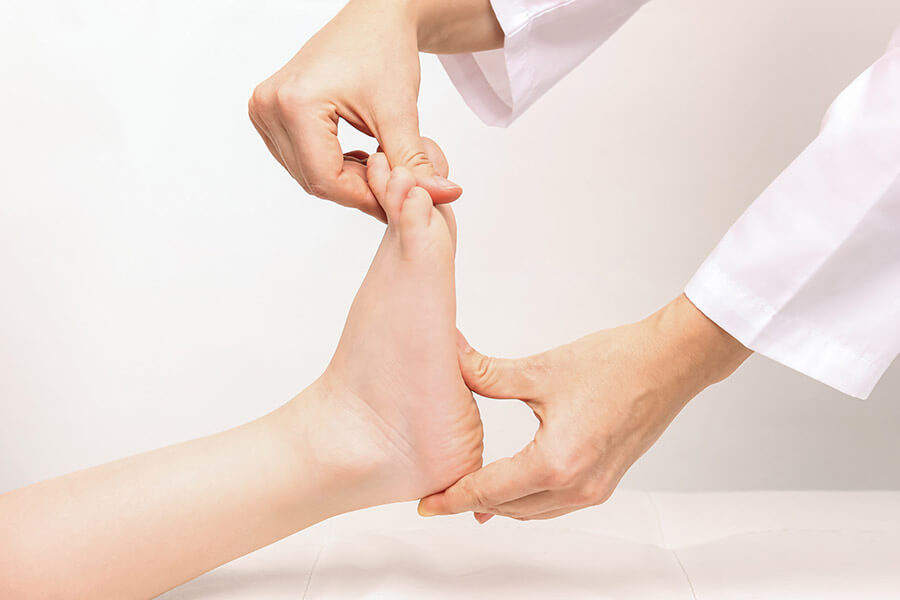- Find a Doctor
- Services & Specialties
-
-
Services & Specialties
-
-
-
-
- Find a Location
- News & Resources
-
-
News & Resources
- Welcome Our Newest Doctors
- Latest News
- Learn More About Our Surgery Centers
- Why Proliance Surgeons?
- Meet Our Leadership
- Meet Our Board
- Contact Us Today
- Pay My Bill
- Career Opportunities
- Mission, Vision, Values
- Phreesia FAQ
- Insurance Plans
- Medical Records
- Balance Billing Protection Act
- PELTO Health Partners
- Revenue Cycle Credit Resolution
- Proliance Surgeons Foundation
- 24/7 Care Info
-
-
-
-
- Pricing
Arch Conditions: Arch Disorders & Flatfeet
Arch disorders not only affect a person’s walk but can be a painful condition requiring surgery to correct both the arch and its appearance. Some conditions can occur due to a foot deformity and may be present from birth, while others result from direct injury and structural issues.

Types of Arch Disorders & Treatments
There are a range of conditions that affect the arch of the foot. To treat conditions affecting the arches, there are several options available to patients that both restore proper gait (walking) and the look of the feet. Read below to learn more about some of the more common disorders and their treatment options:
Flat Feet (Pes Planus)
A condition where the arch of the foot collapses, causing the entire sole of the foot to come into contact with the ground.
Symptoms
- Pain or discomfort in the arch or heel area
- Fatigue or achiness in the feet, especially after standing or walking for long periods
- Overpronation (foot rolling inward excessively while walking)
- Difficulty finding comfortable shoes or experiencing shoe wear patterns on the inner side
Treatment Options
- Supportive footwear with arch support or custom orthotic inserts
- Physical therapy to strengthen foot muscles and improve the gait
- Stretching exercises to alleviate tightness in calf muscles and Achilles tendon
- Weight management and lifestyle modifications to reduce stress on the feet
High Arches (Pes Cavus)
High arches occur when the arch of the foot is abnormally raised, leading to excessive pressure on the heel and ball of the foot.
Symptoms
- Pain or pressure on the ball and heel of the foot due to decreased shock absorption
- Difficulty finding shoes that fit properly, especially in the arch area
- Increased risk of ankle sprains and stress fractures due to poor weight distribution
- Clawed toes or calluses on the ball or heel of the foot
Treatment Options
- Supportive footwear with cushioning and shock absorption
- Custom orthotic inserts to provide additional arch support and redistribute pressure
- Physical therapy to improve foot flexibility and strengthen muscles
- Stretching exercises to alleviate tightness in calf muscles and plantar fascia
Plantar Fasciitis
Inflammation of the plantar fascia, a thick band of tissue that runs along the bottom of the foot and connects the heel bone to the toes.
Symptoms
- Sharp pain or stiffness in the heel, particularly in the morning or after prolonged rest
- Pain that worsens with activity, especially walking or standing for long periods
- Tenderness or inflammation along the bottom of the foot, particularly near the heel
- Difficulty flexing the foot or toes upward
Treatment Options
- Rest and activity modification to reduce inflammation and allow healing
- Orthotic inserts or night splints to stretch the plantar fascia and alleviate pressure
- Nonsteroidal anti-inflammatory drugs
- (NSAIDs) to reduce pain and inflammation
- Physical therapy to strengthen foot muscles and improve flexibility
- Corticosteroid injections for severe or persistent cases
- Extracorporeal shock wave therapy (ESWT) for resistant cases
Posterior Tibial Tendon Dysfunction (PTTD)
A condition where the posterior tibial tendon, which supports the arch of the foot, becomes inflamed or torn, leading to pain and instability in the foot arch.
Symptoms
- Pain or swelling along the inside of the ankle or arch of the foot
- Difficulty standing on tiptoe or pushing off while walking
- Progressive flattening of the arch over time
- Ankle instability or weakness, especially on the inside of the foot
Treatment Options
- Immobilization with a walking boot or brace to allow the tendon to heal
- Orthotic inserts or custom ankle-foot orthoses (AFOs) to support the arch and reduce stress on the tendon
- Physical therapy to strengthen surrounding muscles and improve foot mechanics
- Corticosteroid injections for pain and inflammation
- Surgery to repair or reconstruct the damaged tendon in severe cases
Tarsal Coalition
A condition present from birth (congenital) where two or more bones in the foot fuse together abnormally, leading to stiffness and pain in the foot arch.
Symptoms
- Stiffness or limited range of motion in the foot or ankle
- Pain or discomfort in the arch or midfoot area, especially during physical activity
- Difficulty walking or standing for long periods due to foot fatigue
- Visible or palpable bony lump or prominence on the foot or ankle
Treatment Options
- Immobilization with a cast or walking boot to allow the coalition to heal
- Custom orthotic inserts or shoes with arch support to alleviate symptoms
- Physical therapy to improve flexibility and strength in the foot and ankle
- Corticosteroid injections for pain and inflammation
- Surgery to remove or separate the fused bones in severe or symptomatic cases
Fallen Arches (Adult-Acquired Flatfoot)
Fallen arches occur when the arch of the foot gradually collapses over time, often due to injury, arthritis, or wear and tear.
Symptoms
- Pain or swelling along the inside of the foot or ankle
- Progressive flattening of the arch over time, leading to foot deformity
- Difficulty standing on tiptoe or pushing off while walking
- Ankle instability or weakness, especially on the inside of the foot
Treatment Options
- Supportive footwear with arch support and motion control
- Custom orthotic inserts or ankle-foot orthoses (AFOs) to support the arch and improve foot alignment
- Physical therapy to strengthen foot muscles and improve gait mechanics
- Corticosteroid injections for pain and inflammation
- Surgery to reconstruct the arch or repair damaged tendons in severe cases
Morton's Neuroma
A thickening of the tissue around the nerves that leads to the toes, often causing pain, numbness, or a tingling sensation in the ball of the foot.
Symptoms
- Sharp, burning pain or tingling sensation in the ball of the foot or between the toes
- Numbness or loss of feeling in the affected area
- Pain that worsens with activity, especially walking or wearing tight shoes
- Feeling like there's a pebble or lump inside the shoe
Treatment Options
- Footwear modifications to reduce pressure on the affected area
- Metatarsal pads or orthotic inserts to redistribute weight and relieve pressure on the nerve
- Corticosteroid injections for pain relief and inflammation reduction
- Alcohol sclerosing injections or cryotherapy to shrink the neuroma
- Surgical removal of the neuroma in severe or persistent cases
Charcot-Marie-Tooth Disease
A hereditary condition that affects the nerves in the feet and lower legs, leading to muscle weakness and deformities such as high arches or flat feet.
Symptoms
- Muscle weakness, particularly in the feet and lower legs
- Abnormal gait or difficulty walking due to foot deformities or instability
- High arches or flat feet, depending on the subtype of the disease
- Numbness, tingling, or loss of sensation in the feet and lower legs
Treatment Options
- Orthotic devices, such as braces or ankle-foot orthoses (AFOs), to improve foot alignment and stability
- Physical therapy to strengthen muscles, improve balance, and maintain range of motion
- Assistive devices, such as canes or orthopedic shoes, to improve mobility and reduce falls
- Pain management strategies, including medications and nerve blocks, to alleviate discomfort
- Surgical interventions, such as tendon transfers or osteotomies, to correct deformities or improve function in severe cases


